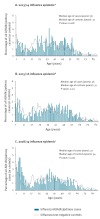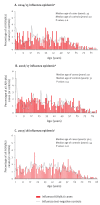Children under 10 years of age were more affected by the 2018/19 influenza A(H1N1)pdm09 epidemic in Canada: possible cohort effect following the 2009 influenza pandemic
- PMID: 30994107
- PMCID: PMC6470369
- DOI: 10.2807/1560-7917.ES.2019.24.15.1900104
Children under 10 years of age were more affected by the 2018/19 influenza A(H1N1)pdm09 epidemic in Canada: possible cohort effect following the 2009 influenza pandemic
Abstract
IntroductionFindings from the community-based Canadian Sentinel Practitioner Surveillance Network (SPSN) suggest children were more affected by the 2018/19 influenza A(H1N1)pdm09 epidemic.AimTo compare the age distribution of A(H1N1)pdm09 cases in 2018/19 to prior seasonal influenza epidemics in Canada.MethodsThe age distribution of unvaccinated influenza A(H1N1)pdm09 cases and test-negative controls were compared across A(H1N1)pdm09-dominant epidemics in 2018/19, 2015/16 and 2013/14 and with the general population of SPSN provinces. Similar comparisons were undertaken for influenza A(H3N2)-dominant epidemics.ResultsIn 2018/19, more influenza A(H1N1)pdm09 cases were under 10 years old than controls (29% vs 16%; p < 0.001). In particular, children aged 5-9 years comprised 14% of cases, greater than their contribution to controls (4%) or the general population (5%) and at least twice their contribution in 2015/16 (7%; p < 0.001) or 2013/14 (5%; p < 0.001). Conversely, children aged 10-19 years (11% of the population) were under-represented among A(H1N1)pdm09 cases versus controls in 2018/19 (7% vs 12%; p < 0.001), 2015/16 (7% vs 13%; p < 0.001) and 2013/14 (9% vs 12%; p = 0.12).ConclusionChildren under 10 years old contributed more to outpatient A(H1N1)pdm09 medical visits in 2018/19 than prior seasonal epidemics in Canada. In 2018/19, all children under 10 years old were born after the 2009 A(H1N1)pdm09 pandemic and therefore lacked pandemic-induced immunity. In addition, more than half those born after 2009 now attend school (i.e. 5-9-year-olds), a socio-behavioural context that may enhance transmission and did not apply during prior A(H1N1)pdm09 epidemics.
Keywords: A(H1N1)pdm09; A(H3N2); Canada; ILI; age; air-borne infections; epidemic; epidemiology; influenza; influenza virus; influenza-like illness; laboratory; laboratory surveillance; pandemic; sentinel surveillance; viral infections.
Conflict of interest statement
Figures



References
-
- Public Health Agency of Canada (PHAC). Weekly influenza reports. Ottawa: PHAC. [Accessed: 22 Mar 2019]. Available from: https://www.canada.ca/en/public-health/services/diseases/flu-influenza/i...
-
- Centers for Disease Control and Prevention (CDC). FluView: Weekly U.S. influenza surveillance report. Atlanta: CDC. [Accessed: 22 Mar 2019]. Available from: https://www.cdc.gov/flu/weekly/
-
- European Centre for Disease Prevention and Control (ECDC). Flu News Europe: Joint ECDC-WHO/Europe weekly influenza update. Stockholm: ECDC. [Accessed: 22 Mar 2019]. Available from: http://flunewseurope.org
-
- Segaloff H, Melidou A, Adlhoch C, Pereyaslov D, Robesyn E, Penttinen P, et al. WHO European Region And The European Influenza Surveillance Network Co-circulation of influenza A(H1N1)pdm09 and influenza A(H3N2) viruses, World Health Organization (WHO) European Region, October 2018 to February 2019. Euro Surveill. 2019;24(9):1900125. 10.2807/1560-7917.ES.2019.24.9.1900125 - DOI - PMC - PubMed
-
- Skowronski DM, Chambers C, Sabaiduc S, De Serres G, Winter AL, Dickinson JA, et al. Integrated sentinel surveillance linking genetic, antigenic, and epidemiologic monitoring of influenza vaccine-virus relatedness and effectiveness during the 2013-2014 influenza season. J Infect Dis. 2015;212(5):726-39. 10.1093/infdis/jiv177 - DOI - PubMed
MeSH terms
LinkOut - more resources
Full Text Sources
Medical
